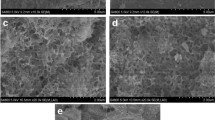Abstract
CuO-Fe2O3 composite material with strong magnetism and a large surface area is prepared by the co-precipitate method. Its adsorption properties towards Acid Red B (ARB) and the regeneration by catalytic combustion of organic compounds have been studied. The results show that the prepared CuO-Fe2O3 composite is an excellent adsorbent for ARB adsorption at acid condition. The presence of Cl− has no effect on ARB adsorption. But the SO 2−4 can inhibit ARB adsorption. After being recovered by the magnetic separation method, the adsorbent can be regenerated by catalytic oxidation of absorbate at 300°C in air atmosphere. The combustion reactions of ARB in the presence or absence of CuO-Fe 2O3 are studied by in situ diffuse reflection FTIR. The results indicate that, in the presence of CuO-Fe2O3, the degradation temperature is significantly lowered by the catalysis of CuO-Fe2O3, and ARB can be oxidized completely without volatile organic compound by-product; in comparison, in the absence of CuO-Fe2O3, the temperature needed for oxidation of ARB is higher and the reaction is incomplete with some N-containing harmful compounds produced. The reusability of CuO-Fe2O3 is also studied in successive seven adsorption-regeneration cycles.
Similar content being viewed by others
References
Gu, B., Schmitt, J., Chen, Z. et al., Adsorption and desorption of natural organic matter on iron oxide: mechanisms and model, Environ. Sci. Technol., 1994, 28: 38–46.
Heijman, S. G. J., Paassen, A. M., Meer, W. G. J. et al., Adsorptive removal of natural organic matter during drinking water treatment, Wat. Sci. Technol., 1999, 40(9): 183–190.
Herrera, F., Lopez, A., Mascolo, G. et al., Catalytic combustion of Orange II on hematite: surface species responsible for the dye degradation, Applied Catalysis B: Environ, 2001, 29: 147–162.
Gonzalez-Pradas, E., Socias-Viciana, M., Saifi, M. et al., Adsorption of atrazine from aqueous solution on heat treated kerolites, Chemosphere, 2003, 51: 85–93.
Zhang, Y., Yang, M., Gao, Y. X. et al., Preparation and adsorption mechanism of rare earth-doped adsorbent for arsenic (V) removal from groundwater, Science in China, Series B, 2003, 46(3): 252–258.
Bandara, J., Mielczarski, J. A., Kiwi, J., Molecular Mechanism of surface recognition, Azo dyes degradation on Fe, Ti, and Al Oxides through metal sulfonate complexes, Langmuir., 1999, 15(22): 7670–7679.
Koji Nakanshi, Solomon, P. H., Infrared Absorption Spectroscopy. San Francisco: Holden-Day. Inc, 1977, 37.
Department of Chemistry, Hangzhou University, Handbook of Analysis Chem., Part III (in Chinese), Beijing: Chemical Industry Press, 1983, 614.
Silverstein, R. M., Bassler, G. C., Morrill, T. C. (Translated by Yao Haiwen, Ma Jinshi, Huang Junxiong et al.), Spectrometric Identification of Organic Compounds, London: John Wiley, 1974, 98.
Author information
Authors and Affiliations
Corresponding author
About this article
Cite this article
Wu, R., Qu, J., He, H. et al. Adsorption and catalytic combustion of ARB on CuO-Fe2O3 . Chin.Sci.Bull. 48, 2311–2316 (2003). https://doi.org/10.1360/03wb0083
Received:
Accepted:
Issue Date:
DOI: https://doi.org/10.1360/03wb0083




